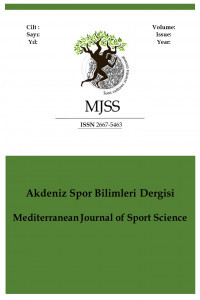Farklı Seviye Liglerde Mücadele Eden Futbolcuların Statik ve Dinamik Denge Testlerinin Karşılaştırılması
Farklı Lig Seviyesi, Futbol, Statik Denge, Dinamik Denge
Comparing Static and Dynamic Balance Tests of Football Players Competing in Different Level Leagues
Different League Levels, Statik Balance, Dynamic Balance, Football,
___
- Amiri-Khorasani, M., & Gulick, D. T. (2015). Acute effects of different stretching methods on static and dynamic balance in female football players. International Journal of Therapy and Rehabilitation, 22(2), 68-73.
- Barber-Westin, S. D., & Noyes, F. R. (2011). Factors used to determine return to unrestricted sports activities after anterior cruciate ligament reconstruction. Arthroscopy: The Journal of Arthroscopic & Related Surgery.
- Can, Y., Sucan, S., Süer, C., & Yılmaz, A. (2005). Aktif futbol oyuncularının çeşitli denge parametrelerinin değerlendirilmesi. Sağlık Bilimleri Dergisi, 14(1), 36-42.
- Dunsky, A., Barzilay, I., & Fox, O. (2017). Effect of a specialized injury prevention program on static balance, dynamic balance and kicking accuracy of young soccer players. World Journal of Orthopedics, 8(4), 317.
- Groeneveld, R. A., & Meeden, G. (1984). Measuring skewness and kurtosis. Journal of the Royal Statistical Society: Series D (The Statistician), 33(4), 391-399.
- Gürkan A.C., Sever O., Er F.N., Suveren C., Kocak M., Hazar M. (2012). The comparison of balance and body fat percentage of elite futsal players and sedentary people. Niğde Üniversitesi Beden Eğitimi ve Spor Bilimleri Dergisi, 6(3).
- Hrysomallis, C. (2011). Balance ability and athletic performance, Sports Med, (3)41: 221-32)
- Jakobsen, M. D., Sundstrup, E., Krustrup, P., & Aagaard, P. (2011). The effect of recreational soccer training and running on postural balance in untrained men. European Journal of Applied Physiology, 111, 521-530.
- Makhlouf, I., Chaouachi, A., Chaouachi, M., Ben Othman, A., Granacher, U., & Behm, D. G. (2018). Combination of agility and plyometric training provides similar training benefits as combined balance and plyometric training in young soccer players. Frontiers in Physiology, 9, 1611.
- Orth, J. D., Thiele, I., & Palsson, B. Ø. (2010). What is flux balance analysis?. Nature Biotechnology, 28(3), 245-248.
- Paillard T., Noe F., Riviere T.,Marion V., Montaya R., Dupui P. (2006). Postural performance and strategy in the unipedal stance of soccer players at different levels of competition. Journal of Athletic Training, 41 (2), 172 – 176
- Paillard, T., Noe, F., Riviere, T., Vincent, M. (2006). Postural performance and strategy in the unipedal stance of soccer players at different levels of competition. Journal of Athletic Training, 41(2), 172.
- Pau, M., Arippa, F., Leban, B., Corona, F., Ibba, G., Todde, F., & Scorcu, M. (2015). Relationship between static and dynamic balance abilities in Italian professional and youth league soccer players. Physical Therapy in Sport, 16(3), 236-241.
- Tabrizi, H. B., Abbasi, A., & Sarvestani, H. J. (2013). Comparing the static and dynamic balances and their relationship with the anthropometrical characteristics in the athletes of selected sports. Middle-East Journal of Scientific Research, 15(2), 216-221.
- Talimciler, A. (2008). Futbol değil iş: endüstriyel futbol. İletişim Kuram ve Araştırma Dergisi, 26(2), 89-114.
- Woollacott, M. H., Shumway-Cook, A., & Nashner, L. M. (1986). Aging and posture control: changes in sensory organization and muscular coordination. The International Journal of Aging and Human Development, 23(2), 97- 114.
- Yayın Aralığı: Yılda 4 Sayı
- Başlangıç: 2018
- Yayıncı: Hasan ŞAHAN
Burakhan AYDEMİR, Murat KUL, Fatih KIRKBİR
Beden Eğitimi ve Sporda Yapay Zeka: ChatGPT ile Yeni Ufuklar
Üstün Zekalı Ortaöğretim Öğrencilerinin Rekreasyonel Farkındalık Düzeylerinin İncelenmesi
Muhammet Eyüp UZUNER, Serkan TURGUT
Zeynep TAN, Sümeyra AKKAYA, Metin KAPIDERE
Takım Sporcularının Mental İyi Oluş Düzeyleri İle Şiddet Eğilimleri Arasındaki İlişki
Engellilik ve Spor Sosyolojisi
Serbest Zaman İlgileniminin İş Tatmini Üzerindeki Etkisi: İdari Personeller Üzerine Bir Araştırma
Fatih YAŞARTÜRK, Mehmet CEYLAN, Buğra AKAY
Profesyonel Futbolcuların Antrenmanlardaki Dış Yük Takibinin İncelenmesi
